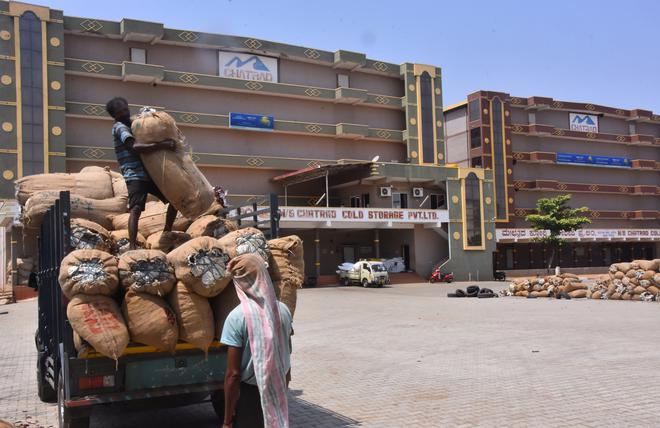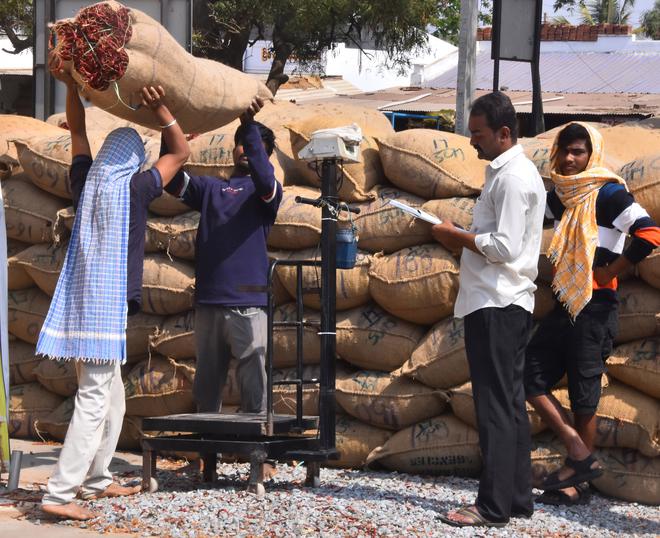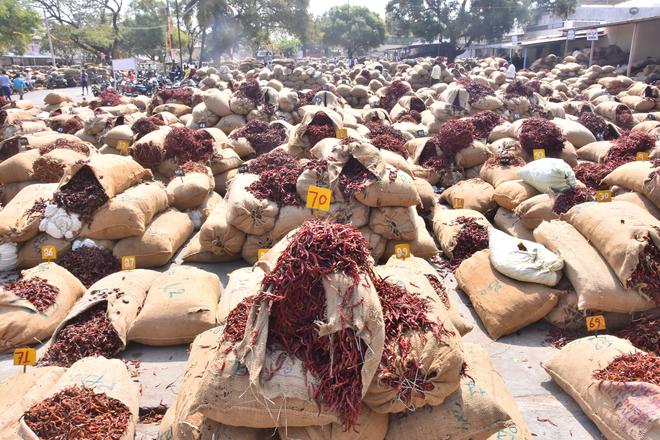It’s 10 a.m. on Monday, and Basavaraj Navale, who works for the commission agent Basavaraj M. Chatrad, is busy assessing the quality of the chilli kept for auction at the Agricultural Produce Market Committee (APMC) yard in Byadgi. Grabbing a handful of chilli pods from the lots containing several bags, he assesses the quality and jots down a few numbers on the notepad he is carrying while an aide opens the gunny bags to show him the pods kept for auction.
Like Basavaraj, there are scores of people with notepads going around the single commodity market yard dedicated to red dry chilli, which is spread over 78 acres in Byadgi town of Haveri district in north Karnataka. The newcomers start sneezing as they pass amid the bags, inhaling the pungent odour, while the likes of Basavaraj, accustomed to the odour, go about their work nonchalantly.

A special variety
The century-old market is known for two primary varieties of chillies: the Byadgi Kaddi and Byadgi Dabbi. The Byadagi Kaddi (Capsicum annum Linn var. Acuminatum Fingerh) is known for lesser pungency and is in high demand because of its very high colour value. While these two are the original varieties for which the Byadgi market is known, the Guntur chilli and around ten other varieties with varying levels of pungency and colour value, which various seed companies have developed, are also available.
The Byadgi Kaddi and Dabbi varieties cultivated in rain-fed areas are considered to be of the highest quality and, accordingly, fetch a high price. These chilli varieties were granted the Geographical Indication (GI) tag in February 2011, with the tag number 129. Those varieties grown under irrigation fetch a lower price, and those varieties developed by seed companies fetch even less.

Not grown in Byadgi
However, quite ironically, both these varieties, which were earlier grown in Byadgi, are no longer cultivated in the vicinity now because of low yield caused by monoculture. Now, they are cultivated in surrounding areas of Kundagol near Hubballi, Vijayapura and Bagalkot districts, all situated in north Karnataka. Ballari district, also in north Karnataka, and the border villages of Telangana and Andhra Pradesh states are the leading producers of chilli. The local farmers have mainly shifted to maize and cabbage gradually over the last two to three decades.
Sudden violence
At a distance from the Byadgi AAPMC yard, sitting under the shade, chilli farmers are engrossed in discussion about the unprecedented violence witnessed a week ago at the same market and the subsequent loss and arrests. They turn away when they notice someone clicking photographs or making videos using a cell phone. A little later, a platoon of CRPF personnel is seen conducting a route march in a bid to reassure their safety.
“This is the first time that I have seen CRPF personnel marching in our APMC yard!” exclaims Basavaraj Chatrad, a second-generation commission agent. “We have seen protests by farmers, which were limited to burning of tyres and roadblocks. Subsequently, the committee members would intervene to hold talks, negotiate and hike prices, and the matter would end there. But this time, it was of a different scale. Never before in the history of the century-old Byadgi market have we heard of such large-scale violence,” he said, recalling the incident that occurred on March 11.
Just several yards away from his office is the APMC office, which now looks gloomy because of the soot caused by the burning of vehicles and office furniture. The final assessment of the damage caused is still underway, and workers are busy washing the building.

What happened on March 11
On the afternoon of March 11, just as the e-tender process at the APMC had concluded for the over 3 lakh bags that were put for auction and the buyers and commission agents had received the successful bids, a mob marched to the APMC office alleging low price for the yield.
Their allegation was that there was a sudden drop of ₹3,000 to ₹5,000 per quintal of chilli. Within no time, the vehicles parked on the APMC office premises bore the brunt of their anger; the office was ransacked and vehicles torched. “We were just writing down the prices for each lot when he heard the commotion,” recalled Basavaraj Navale.
The vehicles were up in flames, and the fire brigade vehicle, which reached the spot, too, was torched. The personnel were manhandled and chased away. The protesting farmers locked the gate and did not allow the police and fire brigade personnel to enter the premises. It was only after additional police force reached the spot that the angry crowd dispersed, and the situation was brought under control. But the damage had been done by that time.
However, surprisingly, the market activities resumed a few hours later, with thousands of farmers turning up to weigh their lots, which continued until late into the night.
The next couple of days saw visits by officials and Minister of Textiles, Sugarcane Development and Agricultural Marketing Shivanand Patil, meeting with farmers and APMC merchants, serious discussion about the reason for the violence, the problems, the demands and so on.
However, what triggered the violence remains unresolved. If the traders are to be believed, even when Byadgi APMC witnessed record arrivals of over 4 lakh bags in the second week of March, the rates were in the same range as those on March 11.
A massive market
Good and fair market conditions in Byadgi have resulted in the Byadgi chilli market expanding year after year. The Byadgi APMC now has 1,125 registered buyers and 1,013 commission agents, and of them, around 400 buyers and agents are active.
During 2022-23, the market recorded a turnover of ₹ 2,281 crore, and this fiscal it is likely to cross the number because of massive arrivals. The expanding market has resulted in the establishment of 32 cold storages in and around Byadgi, with more farmers availing of the facilities to get better prices.
The chilli season begins in November and concludes in May. However, the Byadgi market provides direct employment to several thousand people throughout the year as the stored yield is put for auction even after the season is over.
The market also provides indirect employment to a few thousand people who, like the women from Katenahalli village Nagamma, Bhagya and Renuka, go back home getting higher wages than an average daily wager. They told The Hindu that while a daily wager might earn in the range of ₹400 to ₹500, they earn up to ₹900 on a good day, depending on the quality of the chilli pods they de-stem.
Their average daily earnings are around ₹ 700. The men who load and unload the chilli bags earn up to ₹1,000 per day. Many of the farmers voluntarily give headload workers a few fistfuls of chilli pods as ‘khushi’ (bhakshis), which is an additional income for them.
However, record arrivals and the problem of abundance have resulted in prices falling in recent years, particularly for varieties developed by seed companies. “Even now, good quality Byadgi Kaddi and Dabbi in rainfed areas will fetch over ₹35,000 per quintal. But the same is not the situation of other varieties. The prices have come down from ₹25,000 to ₹10,000 to ₹12,000 now because huge arrivals have exhausted the storage facilities,” says first-generation commission agent Ganesh Achalkar.

Gujarat effect
Another reason cited is the arrivals from the Gondal APMC yard in Gujarat until December led to a drop in prices. The chilli variety from Gujarat is similar to the seed variety (known as 2043) that comes to the Byadgi market, which consequently led to less demand for the local variety.
But the president of Merchants Association, Byadgi, and former MLA Sureshgouda Patil, who is credited with developing the APMC yard in his over four-decade stint as President, believes that low prices were not the triggering point for the violence but the handiwork of vested interests. “The market has been doing really well, balancing the interests of the traders and the farmers. The systematic functioning might have attracted the wrath of vested interests,” he alleges.
Sureshgouda, who took over the business from his father in 1966, is unhappy with successive governments not doing much for the development of the Byadgi chilli even after it got GI tag. He said the problem of space and related issues, including the need for more cold storage, had been brought to the notice of the minister, who has “responded positively.”
However, the traders believe that one cold storage promised by the minister will not be of much use as the increased arrivals demand more cold storage. They want the government to acquire land to help the expansion of the market. As a temporary solution, the merchants association has decided to do business twice in week instead of once a week so as to reduce the burden of handling more arrivals on a single day. The association had earlier decided to do business once a week because of the lack of availability of labour.
While clarifying that the farmers’ organisations would not support any type of violence, Vice President of Karnataka Pranta Raita Sangha (KPRS) U. Basavaraj blamed the situation on what he termed the successive governments’ “pro-corporate” policies, which are leading to the monopoly.
As big corporate players start dictating terms, the merchants purchasing the crops for them start quoting less for bulk purchases, leading to a drop in prices. Consequently, such a sudden drop forces the farmers to resort to violent protests like the one at Byadgi APMC, he explained.
But despite all these problems, the farmers from as far as Mantralayam in Andhra Pradesh come to Byadgi with the hope of getting better prices and its ability to handle massive arrivals. Chikkanna from Mantralyam said he comes to Byadgi as he finds it a better market than those near his native place.
Like him, Bhimanagouda from Shankarabande in Ballari district has been coming to Byadgi for close to three decades as he gets a comparatively fair price for the yield, which, he says, is in the range of over ₹5,000 than the local market.
“Byadgi market can handle large volumes. Even if I don’t get the price I am hoping to get, I can put it in cold storage in Byadgi and sell when the prices are up, a facility, which is not available in any other market nearer to us,” he said.
Beyond cooking
Apart from traditional usage, the Byadgi Kaddi and Dabbi varieties of chilli are more sought after in many industries. They are used in the production of pickles, masala products, and chilli powder, as Byadgi chilli allows for the best colour naturally, that too with less pungency. Because of its long-lasting bright red colour, it is used as a colouring agent and also for extraction of Oleoresin (a concentrated form of the spice in solvent form).
Oleoresin is used as a colouring agent in the production of cheese, sauces, and spice mixtures and to to deepen the colour of egg yolk. It is also used in confectioneries, the cosmetic industry (lipsticks), the beverage industry for toning fresh wine, the meat industry, the pharmaceutical industry, the poultry and cattle feed industry and as a dye in the textile industry. Byadgi chillies are also being used as substitutes for paprika by oleoresin manufacturers in Sri Lanka, Bangladesh, America, Europe, Nepal, Indonesia and Mexico. From Byadgi, the chilli goes to the leading exporters located at Cochin (Kerala), Tamil Nadu, and West Bengal, and in turn, after value addition, products like Paprika Oleoresin are exported.
(Source: National Institute of Food Technology Entrepreneurship and Management, Haryana)







